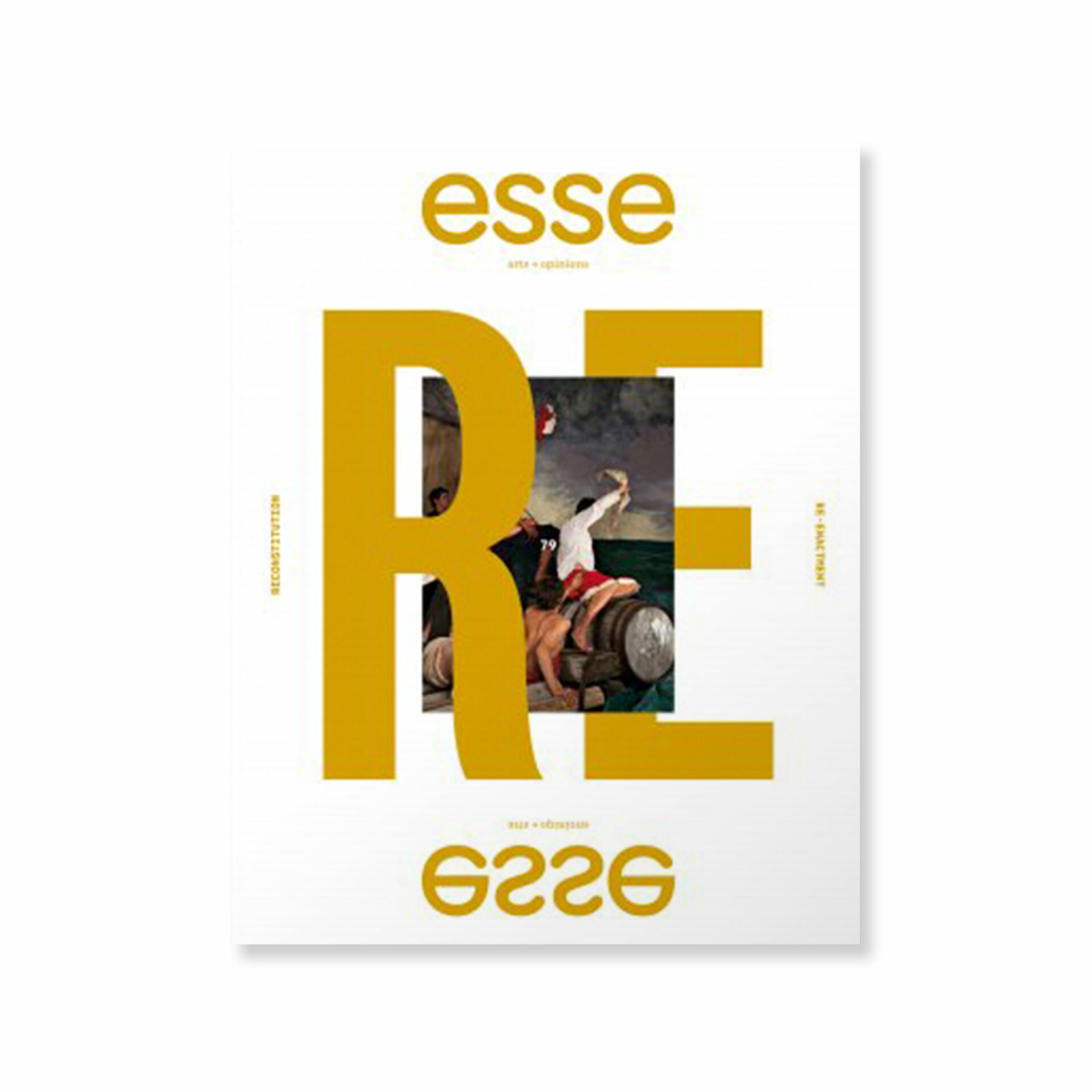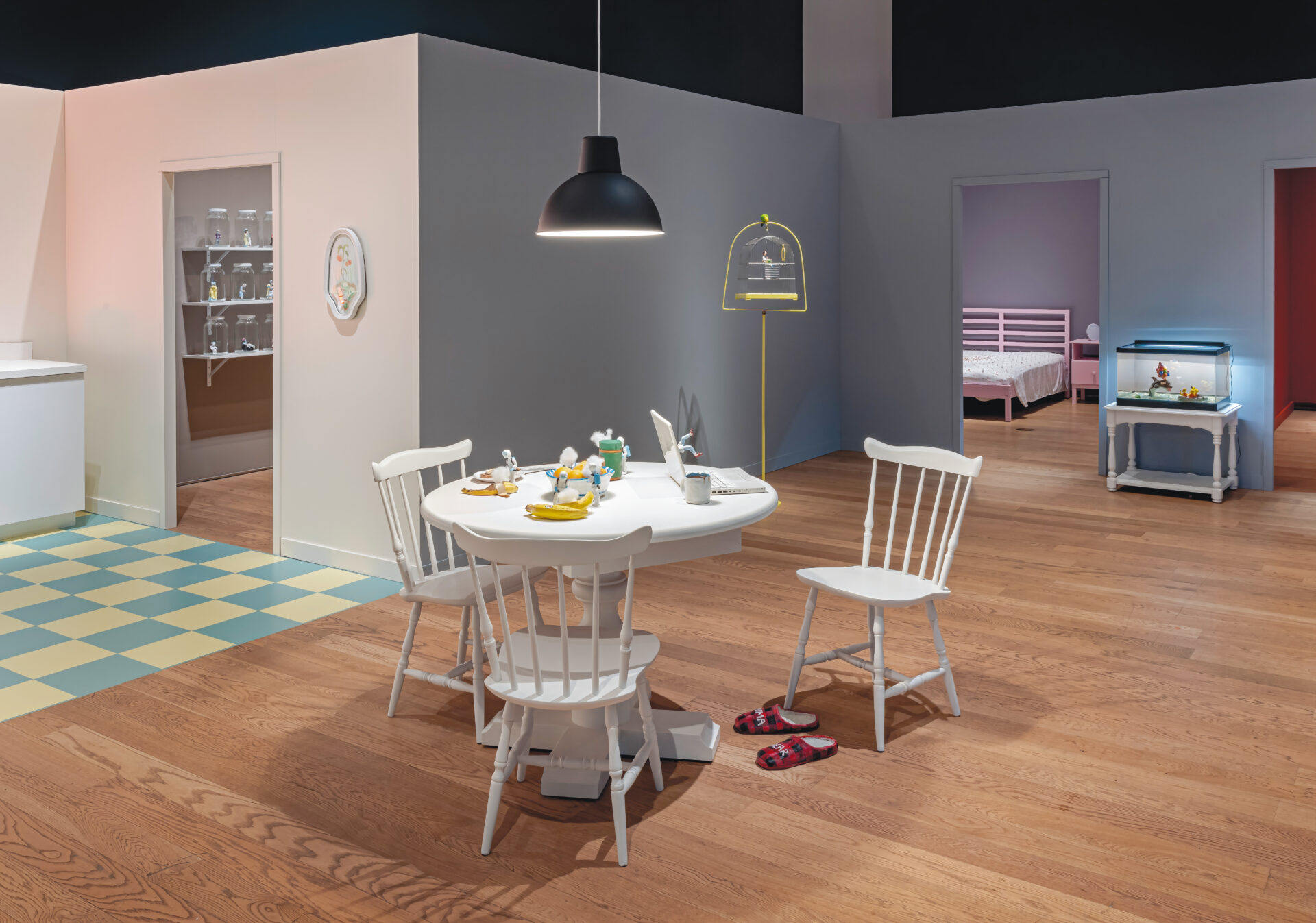
Girl In The Reeds With Bolex, 2010.
Photo : timothy Harrison Raab, courtesy of the artist
[En anglais]
Maple syrup, hockey, poutine, caribou, and Timbits: this is the stuff of Denise Markonish’s Canada.1 1 - In the introductory essay of the Oh, Canada catalogue, Markonish mentions these among other quintessentially “Canadian” tokens to introduce the topic of Canadian culture. Markonish, a curator at the Massachusetts Museum of Contemporary Art (MASS MoCA), recently organized a monumental survey exhibition of Canadian art, aptly titled Oh, Canada: Contemporary Art from North North America. The exhibit held a strong roster of Canadian artists and myriad works engaging with diverse topics; its attempt to relay an affect of “Canadianness” begs varied and imploring questions regarding curatorial methods, the state of regionalized contemporary art in an increasingly globalized market, and art’s irresolute relationship with nationalism. The cultural implications of Oh, Canada conflate issues of curatorial authorship, institutional mandate, and the affective potential of the exhibition as medium, among many other variables. Here, disrupting such conflation, both the curatorial impetus and the exhibition as medium will be used to query the conditions that comprise Canadian identity, a fictive or perhaps mythical entity, and its vexed relationship with contemporary art.
Oh, Canada, whichtook place from May 2012 to April 2013, sprawled across the expanse of several rooms and corridors on the first and second floors of MASS MoCA’s formidable exhibition space.2 2 - MASS MoCA is housed within a converted nineteenth-century factory space in North Adams, MA. With over a hundred thousand square feet of exhibition space, it markets itself as, “the largest center for contemporary arts in the United States.” http://www.massmoca.org/facts.php. Some larger rooms contained several works, often in different media, while other spaces were smaller, more intimate, and showcased one artist or one large work.3 3 - A lengthier investigation could query the relationship between the exhibition installation and the organization of the catalogue. Throughout this article I address the exhibition itself as a medium — it should be noted that the catalogue is also a related yet distinct medium. There exists an overlap between the two, however: the physical installation of the exhibition did not correspond to the thematic groupings proposed in the catalogue, and the resulting dissonance speaks to a distinction in mediums and suggests certain shortcomings in exhibition design. Including artworks from more than sixty artists, collectives, and collaboratives, hailing from every province and most territories, Oh, Canada — and Markonish as its curator — attempted to speak to the profusion of artistic practices inherent in Canada’s contemporary art landscape. Internationally known artists, including Michael Snow, Shary Boyle, Marcel Dzama, Michel de Broin, and Douglas Coupland were exhibited alongside artists akin to Amelie Atkins, Eryn Foster, Craig Leonard, and Clint Neufeld, whose practices, while locally acclaimed, have yet to gain exposure internationally. The exhibition layout eschewed any adherence to topical, chronological, or geographically specific organization, relying instead on the art’s implicit Canadianness as the overarching organizational mechanism.4 4 - While the exhibition did include artists from all provinces and nearly every territory, the cultural specificity of particular regions within Canada was left unaddressed. Complex and nuanced culturally specific regions of art, such as those found in Quebec for example, were homogenized within the greater trope of “Canadianness” in the exhibition. With an overarching theme of identity, particularly Canadian identity, the absence of regional art that addresses cultural specificity further compounds the issue of a national cultural art landscape. What then is Canadian art and what does it look like?
“We made it in America,” proclaims Divya Mehra’s Hollow Victory (You gotta learn to hold ya Own. They get jealous when They see ya with ya mobile phone), 2012. The words, in white and purple neon, sit boldly below a white rainbow. Flickering and flashing, Hollow Victory alludes to the broken ambitions of shoddy storefront spaces with dilapidated signage, rife with the realized shortcomings of “making it.” The ruins of broken dreams. Positioned above a doorway, the statement is imbued with simultaneous longing, irony, and triumph; Mehra’s work is the first thing visitors to the exhibition are confronted with. An obvious curatorial choice, brazenly commenting on a constructed relationship of longing between “others” and the coveted “America,” what remains less obvious is how this work challenges the fundamental curatorial and exhibition premise. The attempt to create a comprehensive survey of Canadian art, with a teleology of ascertaining an understanding regarding Canadian culture writ large (which Markonish alludes to in her curatorial essay), instead creates a complex system of othering that serves to widen an imagined gap between the perceived cultures of Canada and America respectively. Mehra’s work further compounds this conundrum by virtue of her complex cultural identity: her dissonance as a child of immigrant parents, a theme explored widely within her oeuvre, speaks to the inherent plurality of Canadian identities. The multiplicity of Canadian subjectivities foregrounds the impossibility of a cohesive aesthetic of Canadian art.
Markonish’s curatorial enterprise employed the medium of the exhibition in an attempt to create and evoke an aura of Canadian nationhood. Her selection process, which she addresses at length in the catalogue essay for Oh, Canada, and consequent theorization of Canadian art speak to a willingness to transmit or evoke this affect to visitors of the exhibition. Amalie Atkins’s work, comprising a red felt tent (Three Minute Miracle: Tracking the Wolf, 2008), Cedar Tavern Singers’ rendition of “Oh, Canada,” (Oh, MASS MoCA, 2012), and Janice Wright Cheney’s felt rosette bear (Widow, 2012), for example, an overtly engage with notions of Canadian identity. Markonish attempted to juxtapose such stereotypes of nationalism with works of art that did not exude “Canada,” in an effort to convey the complex and nuanced cultural tropes of Canadian art. Something went wrong though: the mark was missed. The affect transmitted by the exhibition was confused, schizophrenic, and nebulous, mirroring the parallel that Reesa Greenberg draws with schizophrenia, as “an appropriate term to use when characterizing Canada’s. . . attempts to define itself (my emphasis).”5 5 - Reesa Greenberg, “Defining Canada,” Collapse 3 (1998): 99. Why was Oh, Canada, as an exhibition, inept in creating the affective experience of “Canadianness”? Metaphorically, all of the puzzle pieces were present; perhaps it was because they failed to create the picture on the box? Or yet, perhaps the picture on the box does not exist at all.
In his seminal text Imagined Communities, Benedict Anderson theoretically articulates the intricate system of relations inherent in the formation of nationhood.6 6 - Benedict Anderson, Imagined Communities: Reflections on the Origin and Spread of Nationalism (London: Verso, 1991). He maintains that nationality is based upon perceived similarities among individuals residing within the boundaries of discrete national spaces. Such a space is thus used to derive a shared national identity, which according to Anderson is imagined by virtue of the impossibility of knowing any number of those sharing such a space. If notions of nationalism are largely imagined and thus to an extent fictive, then Markonish’s enterprise was an impossible feat from its inception: if Canadian identity as such does not exist as a coalesced entity, using a selection of contemporary art to distill it within an exhibition would then seem to be an exercise in futility. The presumption that art inherently relays nationhood is fraught with ambition regardless, and when such a relationship is further complicated by nationhood being fictive, it seems a reasonable outcome that the selection of artwork in Oh, Canada was incapable of conveying Canadianness.
The impulse to distill Canadian identity within an exhibition of contemporary art recalls ethnographic methods of studying a culture perceived as other than one’s own, in this instance the assumed otherness of Canadian culture from that of the United States. This flawed methodology illuminates the need for a reconsideration of both curatorial authority and the binaric relationship between Canada and the United States. A critique of the exhibition in this regard is also necessarily a critique of curatorial authority, as the premise of Oh, Canada was conceived by Markonish, and the subsequent curatorial (or perhaps ethnographic) research, in the form of an in-depth three-year series of studio visits in Canada, is inextricably associated with the exhibition impetus. The pursuit of Canadian art implies a cultural disparity between two nations and a definitive, more obvious form of national art.
Is a work of art “Canadian” by virtue of it being created by a Canadian artist? What then is a Canadian artist? Is it someone born in Canada, or perhaps a citizen with permanent residency? Or further still, is a Canadian someone indigenous to Canada? Perhaps “Canadian” art is that which is created on Canadian soil? Within one of the ten provinces or three territories? As these questions suggest, the fundamental nature of Canadian art is a messy matter: complex, nuanced, and intricate. To select a cross section of art for an exhibition with the intention of evoking a feeling of “Canadianness,” even if that feeling is one of plurality characterized by the inherent proliferation of identities as Markonish alludes to in the exhibition catalogue, is an exercise in cultural homogenization, an ode to a Canadian identity that does not exist. While Oh, Canada provided a host of interesting contemporary art, its failure to fully evoke “the Canadian” is attributable to Canada’s slippery, plural, and potentially mythical nature: within this failure is an exposure of art’s fraught relationship with nationality and the discursive limits of nationhood, eh?




